Garmin Forerunner 735XT Review: Triathlete Triple Threat
Although it offers almost too much data, the Garmin Forerunner 735XT can track running, swimming and biking, as well as deliver phone notifications.
Why you can trust Tom's Guide
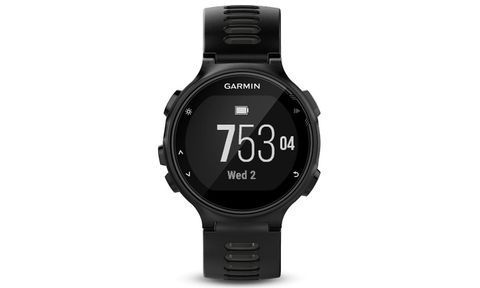
There are smartwatches, there are running watches, there are fitness trackers, there are heart rate monitors, and there are watches for triathletes. The new Garmin Forerunner 735XT aims to be all of those things in a single device. At $449, the Forerunner 735XT doesn't come cheap, but it's worth the price if you're serious about improving your training.
Design
The Forerunner 735XT comes in two color combinations: black / gray and midnight blue / frost blue. The watch face is separate from the band, which allows it to lie flat when you're charging it or otherwise not wearing it.
At 1.75 inches in diameter, the Forerunner 735XT is a large watch, though it's a hair smaller than the Forerunner 235. It is light (1.4 ounces) and thin (less than half an inch), which makes it comfortable. Still, people with smaller wrists may find that it's a bit too big for a watch that's designed to be worn all the time.
MORE: Best Fitness Trackers for Running, Swimming and Training
Water Resistance
The Forerunner 735XT has a 5 ATM water rating. This means that you can wear it while you're swimming or showering, and you don't have to worry about using the watch in a bad rainstorm. (I did not get to take the watch for a swim, and luckily, I did not have to test its durability during a freak summer downpour.) The watch's optical heart rate monitor won't work if you're swimming, but you can wear a compatible chest-strap HRM to collect that data during your swim.
Display
Of course, with a big watch face comes a big display: 215 x 180 pixels. As with the Forerunner 235, the screen is flat on the top and bottom, but rounded on the sides. The display is easy to read, even in direct sunlight, and packs in a lot of information during and after a workout.
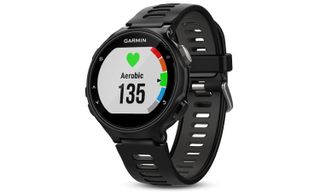
The Forerunner 735XT doesn't have a touch screen, but that makes sense, considering it's designed to be worn while you're swimming. The buttons on both sides of the watch are clearly labeled: Backlight, Up and Down on the left side, and Forward and Back on the right. They are also quite tactile; you can't push them just by bumping the buttons up against your wrist — which you might do in the middle of a weight- or cross-training workout. (You can also lock the buttons during an activity.)
The display is easy to read, even in direct sunlight, and packs in a lot of information during and after a workout.
Hit the Down button on the watch to cycle through the watch's various screens, which include heart rate, a summary of daily activity and a summary of your last saved workout. I liked this feature, since it meant that I could look up workout stats without using the Garmin Connect app. If you have enabled the Forerunner 735XT to receive notifications, you can also view calendar events, the weather and any notifications you usually get on your phone (more on that below).
Performance
Like other Garmin devices, the Forerunner 735XT prominently displays a red Move bar, which tells you if you haven't registered any steps in 2 hours and disappears after a short walk. I understand that Garmin is aiming for consistency across its devices, but a Move bar on a watch that's designed for serious athletes who are self-motivated to exercise seems unnecessary to me.
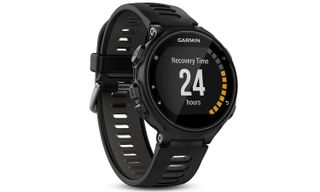
I started my first run without waiting for a GPS signal. No matter — the Forerunner 735XT was able to record distance and pace while also looking for a signal. After a little more than 3 minutes, I saw a notification that the watch had found a signal, and it continued to record the run without a hitch. Having used watches that sometimes needed 30 seconds or more to find a GPS signal, I appreciated this feature a lot. On subsequent runs, the watch found a signal within seconds — I barely had time to start stretching.
MORE: The Best GPS Watches for Sports and Athletics
Once you start running or biking, the Forerunner 735XT display switches from white text on a black background to black text on a white background. But since the display is clearly visible in direct sunlight, I barely noticed this change.
Accuracy
When I first put on the Forerunner 735XT, my heart rate was about 30 beats per minute higher than normal, and I was a bit alarmed. After an hour, I realized that the HRM was just calibrating itself, and the heart rate readout on the watch reverted to what was normal for me. I also noticed that I needed to put the watch on a few minutes before a run (if I wasn't wearing it already) if I wanted the HRM to collect data during a run.
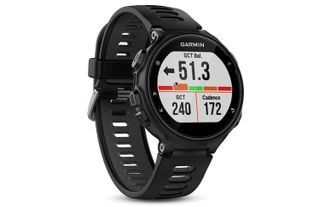
Overall, the Forerunner 735XT's HRM is somewhat accurate. On a 6-mile run, it measured a peak HR of 187 beats per minute and an average HR of 157, which compared to a peak of 165 and an average of 142 on a Polar chest-strap heart rate monitor. Things were better on a second run, when the watch measured a peak HR of 190 and an average of 160 for 10 miles, compared to a peak of 184 and an average of 166 for the Polar device.
This wasn't surprising, as chest-strap HRMs are more accurate than those worn on the wrist, but it was a bit disappointing, given the cost of the Forerunner 735XT. The watch seems to measure a greater range of heart rates than the chest strap.
A Move bar on a watch that's designed for serious athletes who are self-motivated to exercise seems unnecessary.
As for distance, the Forerunner 735XT measured the same running route as 3.02 and 3.03 miles, compared to about 3.05 miles when I mapped it on the Gmap Pedometer (now Milermeter). This was a bit more accurate than my Fitbit Surge, which measured those runs as 3.05 and 3.13 miles.
Finally, the pedometer is also on point. On two separate 500-step walks, the Forerunner 735XT counted 503 and 497 steps.
Data
After you save a workout, the Forerunner 735XT will tell you if you set any personal records during that workout. For running, these records include fastest 5K, fastest 10K and longest run. The watch will also provide an estimated recovery time for the workout, again based on intensity and duration. After an 8.8-mile run that took about 68 minutes, the Forerunner 735XT told me I would need about 36 hours to recover.
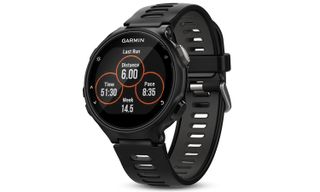
As you view workout details on the watch, there's even more data, including calories burned, elevation and run cadence (or strides per minute). I learned that I max out at just under 180 strides per minute, which Garmin said is the target for most runners. I've been running for almost 21 years, and I never knew this.
There's also a Training Effect number, which uses your heart rate to measure the intensity of the exercise to indicate if you are simply maintaining your fitness level or improving it. For my short runs, my Training Effect number was between 3 and 4 (improving), but it was 4, or highly improving, on my longest run.
For biking, you can view distance, pace and average speed at a quick glance. View workout details and you also see top speed, average and maximum heart rate, calories burned and Training Effect.
MORE: Who Has the Most Accurate Heart Rate Monitor?
There's a lot of information to view on the Forerunner 735XT itself, and it can be overwhelming. To view it all, I found the mobile version of Connect easier to navigate than the browser version. The browser crams several modules on the screen at a time, while the mobile app allows you to swipe from one module to another. You can customize which modules appear on both the browser and mobile app, but the browser version of Connect is difficult to de-clutter.
Notifications
Garmin has designed the Forerunner 735XT to be a semi-smartwatch in addition to a fitness watch. It can be set up to receive notifications — social media messages, texts, calendar events and so on — that you receive on your phone. (There is a Do Not Disturb mode that will turn off notifications in the middle of a workout, and you can change this setting on the watch itself, without logging into Garmin Connect.)
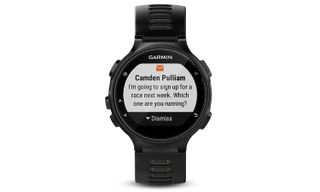
Notifications were easy to set up, but I had two problems with them. One, dismissing a notification on the watch also dismisses that notification on your phone. (To be fair, both Garmin and my phone indicated that this would happen.) This bothered me, since you can only view notifications on the Forerunner 735XT, and have to grab your phone in order to reply.
Two, for the sync function to work on the device, your phone's location must be enabled at all times. I only use location services on my phone when it's absolutely necessary, in order to save the battery and not broadcast my location to all the apps I use.
In short, receiving notifications on the Forerunner 735XT can be useful, but it's not for everyone. I ended up turning off notifications after about a day.
Battery Life
Out of the box, the Forerunner 735XT battery was already at 80 percent. This was a welcome change from devices that you must immediately plug in before you can commence startup. It only took 15 minutes to charge the battery to 100 percent, too. The charger consists of a small clip connected to a USB plug, so it easily fits on a desk or shelf.
According to Garmin, the battery will last up to 11 days in watch mode, which includes activity tracking, smart notifications and optical heart rate tracking. After I wore the watch for eight days and tracked four runs (using both the HRM and GPS) that lasted more than two and a half hours total, the battery was still at 28 percent, and it only took an hour for it to get a full charge.
In activity mode, the battery will last up to 14 hours with GPS and optical HR, according to Garmin. This means that the device should be able to track an entire 100-mile bike ride without needing to be recharged.
All told, the Forerunner 735XT has an impressive battery. If you're training for a marathon, long bike race or triathlon, you won't have to worry about charging the device after every long workout. The watch can also store up to 80 hours of activity data, according to Garmin, which offers peace of mind to anyone who frequently deletes data from a watch.
MORE: GPS Watch Buying Guide
Extras
If the features included with the Forerunner 735XT aren't enough, Garmin also sells two bundles. The Run Bundle ($499) comes with the watch and the HRM-Run, which uses torso movement to measure cadence, vertical oscillation and ground-contact time. The Tri-Bundle ($599) comes with the watch, the HRM-Tri (designed for bike rides and brick workouts) and the HRM-Swim (designed for swimming).
In addition, the watch is compatible with Garmin's Varia and Vector lines of bicycle accessories.
Bottom Line
If the Garmin Forerunner 235 is a serious running watch, then the Forerunner 735XT is a serious triathlete's watch. It collects the same running data as the Forerunner 235 and also supports bicycling and swimming — including all three in a single workout. The watch also includes the features you'd expect in a smartwatch, from a step tracker to smartphone notifications.
At times, everything you get with the Forerunner 735XT can be a bit much. That said, it's easy to use the Garmin Connect app to customize your experience. And the Forerunner 735XT's battery life and accuracy are hard to beat.
Sign up to get the BEST of Tom's Guide direct to your inbox.
Here at Tom’s Guide our expert editors are committed to bringing you the best news, reviews and guides to help you stay informed and ahead of the curve!
Brian Eastwood is a freelance writer for Tom’s Guide, focusing primarily on running watches and other wearable tech. Brian has been a professional writer and editor since 2003. He has covered healthcare tech, enterprise tech, higher education, and corporate leadership for a range of trade publications. Brian is a lifelong Massachusetts native and currently lives outside of Boston. Outside of work, he enjoys running, hiking, cross-country skiing, and curling up with a good history book.
